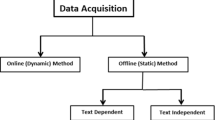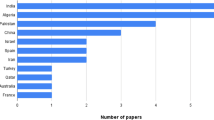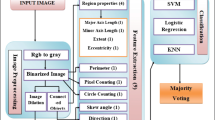Abstract
Features of the handwritten text play a vital role in the area of handwriting identification. It became more challenging when one has to identify gender, age, and handedness of the person through handwriting. In last two decade, the use of various feature extraction techniques immerged having advantages one on the other. Ample research is done on writer identification systems by implementing various feature extraction techniques. In this paper, we have shifted the concern toward various features and features extraction techniques implemented on gender identification through handwriting. The objective of this survey is to present the critical review of work done in area feature extraction in gender identification taking only handwriting into consideration. We have categorized all the feature extraction techniques used by the researchers for gender classification into four broad categories: statistical-, transform-, gradient-, and model-based techniques. From the survey, we have identified few techniques that deserve future attention of the researchers for optimal results.
Access this chapter
Tax calculation will be finalised at checkout
Purchases are for personal use only
Similar content being viewed by others
References
Maken P, Gupta A (2021) A method for automatic classification of gender based on text- independent handwriting. Multimed Tools Appl. https://doi.org/10.1007/s11042-021-10837-9
Bouadjenek N, Nemmour H, Chibani Y (2016) Robust soft-biometrics prediction from off-line handwriting analysis. Appl Soft Comput 46:980–990
Al Maadeed S, Hassaine A (2014) Automatic prediction of age, gender, and nationality in offline handwriting. Eurasip J Image Video Process, 1–10
Siddiqi I, Djeddi C, Raza A, Souici-meslati L (2015) Automatic analysis of handwriting for gender classification. Pattern Anal Appl 18(4):887–899. https://doi.org/10.1007/s10044-014-0371-0
Bi N, Suen CY, Nobile N, Tan J (2019) A multi-feature selection approach for gender identification of handwriting based on kernel mutual information. Pattern Recogn Lett 121:123–132. https://doi.org/10.1016/j.patrec.2018.05.005
Gattal A, Djeddi C, Bensefia A, Ennaji A (2020) Handwriting based gender classification using COLD and Hinge features. In: Image and signal processing: 9th international conference, ICISP 2020, Marrakesh, Morocco, June 4–6, 2020, proceedings, 12119, 233–242. https://doi.org/10.1007/978-3-030-51935-3_25
Ahmed M, Rasool AG, Afzal H, Siddiqi I (2017) Improving handwriting based gender classification using ensemble classifiers. Expert Syst Appl 85:158–168. https://doi.org/10.1016/j.eswa.2017.05.033
Maji P, Chakraborty S, Samanta S, Chatterjee S, Kausar N, Dey N (2015) Effect of Euler number as a feature in gender recognition system from offline handwritten signature using neural networks. In: 2015 international conference on computing for sustainable global development, INDIA Com, 1869–1873
Dargan S, Kumar M (2021) Gender classification and writer identification system based on handwriting in Gurumukhi Script. In: 2021 international conference on computing, communication, and intelligent systems (ICCCIS). (ICCCIS), Greater Noida, India, pp 388–393. https://doi.org/10.1109/ICCCIS51004.2021.9397201
Sokic E, Salihbegovic A, Ahic-Djokic M (2012) Analysis of off-line handwritten text samples of different gender using shape descriptors. In: 2012 9th international symposium on telecommunications, BIHTEL 2012 proceedings
Riza LS, Zainafif A, Rasim, & Nazir, S. (2018) Fuzzy rule-based classification systems for the gender prediction from handwriting. Telkomnika (Telecommun Comput Electron Control) 16(6):2725–2732
Bouadjenek N, Nemmour H, Chibani Y (2017) Fuzzy integrals for combining multiple SVM and histogram features for writer’s gender prediction. IET Biometrics 6(6):429–437. https://doi.org/10.1049/iet-bmt.2016.0140
Bouadjenek N, Nemmour H, Chibani Y (2014) Local descriptors to improve off-line handwriting-based gender prediction. In: 6th international conference on soft computing and pattern recognition, SoCPaR, 43–47
Bouadjenek N, Nemmour H, Chibani Y (2015) Age, gender and handedness prediction from handwriting using gradient features. In: 2015 13th international conference on document analysis and recognition (ICDAR), 1116–1120
Navya BJ, Shivakumara P, Shwetha GC, Roy S, Guru DS, Pal U, Lu T (2018) Adaptive multi-gradient kernels for handwritting based gender identification. In: Proceedings of international conference on frontiers in handwriting recognition, ICFHR, 392–397. https://doi.org/10.1109/ICFHR-2018.2018.00075
Navya BJ, Swetha GC, Shivakumara P, Roy S, Guru DS, Pal U, Lu T (2018) Multi-gradient directional features for gender identification. In: Proceedings—international conference on pattern recognition, 3657–3662
Gattal A, Djeddi C, Siddiqi I, Chibani Y (2018) Gender classification from offline multi-script handwriting images using oriented basic image features (oBIFs). Expert Syst Appl 99:155–167
Akbari Y, Nouri K, Sadri J, Djeddi C, Siddiqi I (2017) Wavelet-based gender detection on off-line handwritten documents using probabilistic finite state automata. Image Vis Comput 59:17–30.https://doi.org/10.1016/j.imavis.2016.11.017
Ibrahim AS, Youssef AE, Abbott AL (2015) Global vs. local features for gender identification using Arabic and English handwriting. In: 2014 IEEE international symposium on signal processing and information technology, ISSPIT, 155–160
Youssef AE, Ibrahim AS, Lynn Abbott A (2013) Automated gender identification for Arabic and English handwriting. In: 5th international conference on imaging for crime detection and prevention, ICDP. https://doi.org/10.1049/ic.2013.0274
Guerbai Y, Chibani Y, Hadjadji B (2018) Handwriting gender recognition system based on the one-class support vector machines. In: Proceedings of the 7th international conference on image processing theory, tools and applications, IPTA 2017, 2018-Janua(4), 1–5. https://doi.org/10.1109/IPTA.2017.8310136
Tan J, Bi N, Suen CY, Nobile N (2016) Multi-feature selection of handwriting for gender identification using mutual information. In: Proceedings of international conference on frontiers in handwriting recognition, ICFHR, 0(Mi), 578–583
Mirza A, Moetesum M, Siddiqi I, Djeddi C (2016) Gender classification from offline handwriting images using textural features. In: Proceedings of international conference on frontiers in handwriting recognition, ICFHR, pp 395–398. https://doi.org/10.1109/ICFHR.2016.0080
Morera A, Sánchez v, Vélez JF, Moreno AB (2018) Gender and handedness prediction from offline handwriting using convolutional neural networks. Complexity https://doi.org/10.1155/2018/3891624
Illouz E, David E, Netanyahu NS (2019) Handwriting-based gender classification using end-to-end deep neural networks. In arXiv (Vol. 1). Springer International Publishing. https://doi.org/10.1007/978-3-030-01424-7
Moetesum M, Siddiqi I, Djeddi C, Hannad Y, Al-Maadeed S (2018) Data driven feature extraction for gender classification using multi-script handwritten texts. In: Proceedings of international conference on frontiers in handwriting recognition, ICFHR, 564–569.https://doi.org/10.1109/ICFHR-2018.2018.00104
Xue G, Liu S, Gong D, Ma Y (2020) ATP-DenseNet: a hybrid deep learning-based gender identification of handwriting. Neural Comput Appl 3. https://doi.org/10.1007/s00521-020-05237-3
Rahmanian M, Shayegan MA (2021) Handwriting-based gender and handedness classification using convolutional neural networks. Multimedia Tools Appl. https://doi.org/10.1007/s11042-020-10170-7
Author information
Authors and Affiliations
Editor information
Editors and Affiliations
Rights and permissions
Copyright information
© 2023 The Author(s), under exclusive license to Springer Nature Singapore Pte Ltd.
About this paper
Cite this paper
Sethi, M., Jindal, M.K., Kumar, M. (2023). Feature Extraction Techniques for Gender Classification Based on Handwritten Text: A Critical Review. In: Basu, S., Kole, D.K., Maji, A.K., Plewczynski, D., Bhattacharjee, D. (eds) Proceedings of International Conference on Frontiers in Computing and Systems. Lecture Notes in Networks and Systems, vol 404. Springer, Singapore. https://doi.org/10.1007/978-981-19-0105-8_19
Download citation
DOI: https://doi.org/10.1007/978-981-19-0105-8_19
Published:
Publisher Name: Springer, Singapore
Print ISBN: 978-981-19-0104-1
Online ISBN: 978-981-19-0105-8
eBook Packages: EngineeringEngineering (R0)




